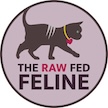Let’s go over the macronutrients of our cats’ diets, how to calculate dry matter basis (DMB), and what ranges to aim for when choosing our cats’ food.
Macronutrients and DMB
First of all, what are the macronutrients? Protein, fat, and carbs are the macronutrients of the diet. The other important macronutrient in the diet is water. Cats need a high moisture diet; it is absolutely essential. I have written about the importance of moisture here and here. Therefore, I am going to focus on the other macronutrients in this blog. The amount of macronutrients suggested is based on these whole prey values & Plantinga (2011).
What is dry matter basis, commonly referred to as DMB? This just means looking at a food with the moisture content removed from the equation. When we use DMB, we can compare different foods with different moisture contents since they are not all the same.
Protein
Let’s start with protein. Cats naturally eat a range of ~50-72% protein in their diets, with an average of 58%. Protein is made from amino acids. There are essential amino acids, which must be provided for in the diet, and nonessential, which are created in the body. All of the essential amino acids for that animal must be present in order for protein synthesis to occur.
Cats have 11 essential amino acids, including taurine and arginine, which can only be found in animal sources. This is why plant based sources of protein are not useful to cats. Plant based proteins like beans, peas, lentils, etc., are not appropriate sources of protein for cats because they do not have all 11 essential amino acids needed for protein synthesis. Incidentally, this is why cats cannot eat a vegan diet.
When cats don’t get the protein they need in their food, they will literally take it from their own bodies. Cats eating lower protein foods will often have behavioral issues, such as stealing food or acting constantly hungry. They are actually searching for more protein. This is one of the reasons why cats eating dry food overeat. They are trying to get more protein, not because they are still hungry.

Fat
Cats need a moderate amount of fat in their diet as it is an important source of energy. A range of 9-35% fat, with an average of 30%, on dry matter basis (DMB) is in line with their natural diet and Plantinga’s study.
Fat is an important energy source, helps transport fat soluble vitamins in the body, and makes food more palatable.
Grocery store fat ratios
It can be confusing to know how much fat the meat in the grocery store has because it is listed on an as-fed basis rather than DMB. You want meat that has no more than 10% fat on an as-fed basis. 10% fat probably doesn’t sound “moderate,” but 90/10 meat actually has ~33% fat once the water is removed.
93/7 meat has ~25% fat
80/20 meats have ~52% fat
This means those meats with 20% fat as-fed actually have more fat than protein!
But maybe you want to include lamb or duck in the rotation, which are naturally higher in fat. No worries. You can still feed those, just follow one of the following options: (1) you can pair a higher fat meat with a leaner meat to create a better fat profile as a mixed protein batch or (2) feed a single protein batch made with a higher fat meat, and then feed a leaner meat next in the rotation to create balance over time.
Figuring out the protein and fat content of meat
You can use the information from this USDA database to determine the fat and protein content of raw meats on DMB. The Legacy Foods section will have many of the meats that we commonly use in raw feeding, but also some less common ones, like elk and venison.
Using the information from the database mentioned above, let’s use raw rabbit as an example. This formula will help you determine the protein and fat content of meats on DMB:
- First, subtract the water content from 100: 100-72.8=27.2
- Then divide the protein by that number: 20/27.2, and multiply by 100=73.5% protein DMB
- And divide the fat by the same number: 5.55/27.2, and multiply by 100=20% fat DMB
Carbohydrates
Next up is carbohydrates. How much carbohydrates does your cat require in their diet?
None.
That’s right, cats have NO nutritional requirement for carbohydrates. Zero.
Cats do not use carbohydrates for energy like we do. They use protein & fat for energy.
So, why are carbohydrates included in cat foods? Carbohydrates are used in commercial foods because they are much cheaper than meat. The other reason is because dry kibble needs carbohydrates to hold the “food” together. Neither of these reasons have anything to do with cats and their nutritional requirements.
A small amount of carbohydrates can be used for fiber if not using animal based sources of fiber. Psyllium husk is a popular option. I previously wrote about fiber here.
The general rule of thumb is to aim to feed commercial foods with carbohydrates under 10% DMB.

Time for some math
Since cat food manufacturers don’t have to include the carbohydrate amount on pet food labels, we have to determine that important piece of information ourselves. One of the sneaky aspects of the pet food industry is that the carbohydrate content of pet foods is not required on the label. Grrrr.
Using the guaranteed analysis
That’s ok though, we can figure it out using the Guaranteed Analysis (GA) of a food. You can find the GA right on the package and it should also be available on the company’s website. This will provide a rough estimate of the macronutrient content.
Here is the GA for Small Batch Pork Frozen Raw Cat Food:
Crude Protein: 15.7% min
Crude Fat: 7.1% min
Fiber: 0% max
Moisture:72.6% max
Ash: 3.5% max
Grab your calculator
Step 1: Add up the percent of protein + fat + fiber + moisture + ash
In this example, 15.7 + 7.1 + 0 + 72.6 + 3.5=98.9
Step 2: Subtract the amount from Step 1 from 100 to determine carbohydrate content
100-98.9=1.1
This food has 1.1% carbohydrates. However, this number includes the moisture, so it is not a very useful number to really understand how much carbohydrates are in this food, so we must convert this to DMB.
Step 3: Dry Matter Basis (DMB)
- First subtract the % of moisture in the food from 100: 100-72.6=27.4
- Next divide the amount of carbs (or protein or fat) from Step 2 by this number: 1.1/27.4=0.040
- Multiply by 100: 0.04 X 100=4%
This food has ~4% carbs on DMB.
You only need to use step 3 to determine the fat and protein content. For example, this same food has ~57.3% protein and ~30% fat. This is an appropriate food in regard to macronutrients since protein and fat fall within the target ranges and it has less than 10% carbohydrates.
Rough estimate only
Keep in mind that when using the Guaranteed Analysis, you are using maximums and minimums, not exact numbers. This will give you an idea of the amount of macronutrients in the food, but it is not exact.
If a company provides a Typical Analysis or Nutritional Analysis, those numbers are more precise. You often have to call a company for that information, which is really annoying. If a company refuses to provide this information, that is a big red flag.
Companies that value transparency will have those numbers readily available. Primal, Fresh is Best, and EZComplete, among others, have nutritional analyses of their foods right on their websites.
You can use the GA to get a rough estimate of the macronutrient content of any commercial food, not just raw, to help you make appropriate choices for your cat.
Give it a try
I encourage you to practice figuring out macronutrient content on DMB. You can use the database to check the protein and fat content of raw meats that you feed and/or use the GA to figure out the protein, fat, and carbohydrates in commercial foods. The more you do it, the easier it becomes. It is an important way for us as pet parents to educate and empower ourselves. Let me know how it goes for you!


